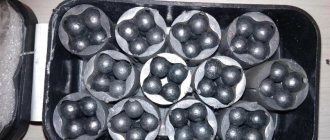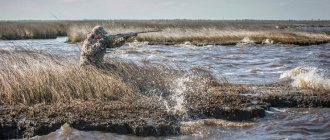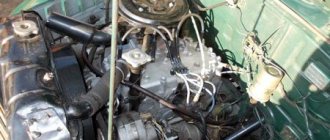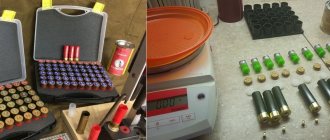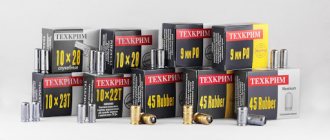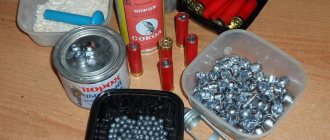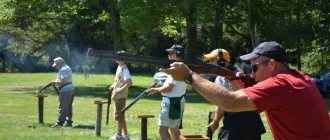Hunting and fishing in the Tver region
Let us dwell on some aspects of equipping cartridges with large shot. To make it easier to understand, let’s denote them point by point. In order not to complicate the material with discussions about deep intra-ballistic processes, we will limit ourselves to only conclusions that may be useful to an amateur hunter who independently loads cartridges. 1. Powder gases after the projectile leaves the barrel for about 46 cm still affect the projectile. There is even specific data on how much the projectile speed additionally increases. If the wads are heavy, they catch up with the shot post and, penetrating into it, push the shot away. Naturally, the accuracy of the battle will decrease. When shooting on the surface of freshly fallen snow, it is easy to see how far wads or containers fly... Often containers, for example, lie at the sighting target at 35 meters... To reduce this negative moment, I cut felt wads lengthwise into 4 segments. After leaving the barrel, they immediately scatter in different directions and do not push the shot.
2. Gas outlets with chambers of 76 and 89 mm. Designed for shooting steel shot (for import). The passports say that they can also use cartridges with a 70 mm sleeve. Of course you can. But still, the combat quality of such cartridges will be somewhat lower. Here, a breakthrough of gases in the projectile entrance is still possible. This will be especially noticeable if thick-walled sleeves are used. The wad, coming out of the cartridge case, does not immediately block the projectile entrance, and gases break through around it... A ring of powder soot will be noticeable at the end of the chamber... It has long been determined at Izhmekh that accuracy in such cases can drop by 4-6%. Especially if wads are used and not containers...
3. Combat from thick-walled cartridges will be better than from thin-walled ones. By thick-walled, I mean the first samples of plastic sleeves (70-80s), paper sleeves of early releases, modern paper sleeves from NMZ “Extra”. The fact is that a strong discrepancy between the inner diameter of the cartridge case and the diameter of the barrel bore leads to excessive crushing of the shot in the projectile entrance. These are all subtle factors, but together they can significantly reduce the battle. Although I know that many people neglect them...
4. Markevich also pointed out the best obturation. There is a simple way to increase it - increase the diameters of the wads. But at the same time, the cartridge becomes barrel-shaped and is tightly inserted into the chamber. Problems may then arise with extraction... And in self-loading, such cartridges are generally unacceptable - there will be delays. The solution is to use plastic seals. Cardboard and wads alone are not enough here. I have made dies with punches for pressing from oil tanks of seals for 18.2 mm and 18.5 mm barrel bores. If there are no such devices, then you can use 16-gauge Sheinin plastic shot wads for 12 gauge. These seals are placed directly on the gunpowder, and then, as usual: two cardboards, a greasy felt wad, cut lengthwise into 4 parts, followed by a non-greased felt wad or fiberboard. If someone tries this method, I assure you, they will immediately feel an increase in the accuracy and especially the sharpness of the battle. Felt wads should also be of different diameters. For the bore 18.2 - 18.9 mm, for the bore 18.5 - 19.2 mm (cardboard spacers are 0.3 mm smaller in diameter).
5. A coarse shot shell will give a good fight only if this shot is consistent with the bore, especially with the choke. The easiest way to check whether the fraction is consistent is by experiment. You need to pour shot into the barrel part of the wad in one layer. The method is old, but reliable. There should be no voids in this layer and vice versa - the pellets should not stick out... There will be few such shot numbers for a given channel - 2-3 numbers. For example, I use coarse shot No. 0 for MC21-12. I never use inconsistent shot for responsible hunting.
6. It has long been proven - the best shock absorber for shot is starch (when equipping at home). N. N. Fokin, a great expert in shot shooting, wrote that starch is the best concentrator for shot in the world. For 12 gauge, 1.2-1.5 g of starch is required per projectile. You can sprinkle the shell with starch in layers, followed by shaking. I make it simpler - I mix the shot in the jar with starch in advance. When you load a lot of cartridges, there is no time and no need to tinker with each cartridge for a long time. I would like to emphasize that starch will give its full positive result only if the shot is coordinated with the bore.
7. I only use “Falcon” gunpowder. Fast-burning powders “Sunar”, “Bars” and others are very sensitive to various components of cartridges, the method of projectile, the compression of cartridge components in the cartridge case, the method of sealing the cartridge case, and calibers. It is no coincidence that the plant does not even provide for equipping 20, 28, 32 caliber cartridges with these types of gunpowder. And there is no data on these calibers on the cans... It is more difficult to test a good cartridge with these types of gunpowder at home. It will take a long time to experiment with different attachments and different equipment. You should ensure that with the maximum shot load for 12 gauge - 36 g, the mass of gunpowder is no less than indicated on the label on the can. Mine is 2.3 g. It is important here not to reduce the sharpness of the battle.
8. Tested in practical shooting - with coarse shot at 60 meters, accuracy increases better when shooting without a container, but consistent with the bore, sprinkled with starch. (The container gives good accuracy and sharpness at positive temperatures when shooting with small and medium shot up to 40-45 meters). The deterioration in the uniformity of combat is especially noticeable when shooting with large shot in a container (not always suitable for a given bore), since the entire process of forming a shot sheaf is disrupted when the shot column passes through the choke constriction. I have previously published a number of special works on this topic. I think that those who are interested in these issues are aware of them.
9. At home, when testing a cartridge with large shot, the container, as mentioned earlier, is not used. Seals and felt wads are used. Here it is necessary to ensure that the front wad can block the projectile entrance before the rear wad leaves the cartridge case. So that there is no breakthrough of gases before the shot. If you use the “Star” method to seal the sleeve, the total height of the wads will be less. There may be a gas breakthrough. This means that by adding an additional wad, we can seal the sleeve only with a twist. That's what I do. By the way, for a self-loading rifle such cartridges do not cause delays.
10. The wedging effect of large shot is lower than that of small shot (the contact area of the shot with the bore is smaller). It is more difficult to create the necessary boost pressure. Therefore, to obtain a sufficient initial shot velocity, the mass of gunpowder must be slightly increased (by 5-10%). That's exactly what the label on the jar says.
11. When shooting geese, you should not take excessively large shot. For No. 00, 000, 0000, the number of pellets in the projectile will be less than for No. 1.0 and there will be more run-out. The overall effectiveness of shooting at long distances will be lower. I'm not talking about buckshot. This is really some kind of harmful, persistent prejudice. You need to take goose (according to Aksakov) shot No. 1 or No. 0). An excessively small shot for a given game will not have the necessary energy to kill as the distance increases. There will be wounded wounds, since the shot will not reach vital organs and will settle in the upper tissues. The heart and other organs will function, pump blood, and the game will “bleed.” The hunter will not get the trophy. For a goose, I allow two pellets to hit the front of the carcass. We were always told about 4-6 pellets in a game carcass. There is no need to pretend to be sacred: practice shows that after two pellets hit, the game is usually yours.
12. The most important issue in internal ballistics is to ensure good shock absorption of the shot. It has been established many times that deformed shot will always give worse accuracy, worse sharpness, and worse uniformity of firing. If you picked up buckwheat-like buckshot from the ground, it means the cartridge was fired incorrectly. There won't be a good fight. The oncoming flow of air, hitting different sides of the pellet, will deflect it from the desired direction of flight... And where does the main crushing of the pellets occur? For some reason, some people think it’s in the choke. No. At Izhmekh, Izmetinsky’s group has long established that the main crushing of the pellets occurs in the cartridge case, 50 mm from the treasury. Hence, for us, practitioners, the most important conclusion is to deform the fraction as little as possible. So the question comes down to the deformation capabilities of the wads. Hard wads are not suitable. If we were talking about felt, we need to select something that is not hard, not heavy, and, of course, clean, without grains of sand and dust... A wad with fiberboard is also good as an additional wad. When compressed, it changes its height (decreases) by 3 times, good felt - by 2 times. When choosing a material, you should always make sure of this by squeezing it tightly with your fingers... Well-chosen wads often provide better shock absorption than the first polyethylene wad-container that comes in... And, of course, the shot is desirable to be hard, spherical, of the same size without cavities and tails.
13. The operation of a greasy felt wad when firing with smokeless powder is not very suitable for stabilizing the intra-ballistic process. During the initial movement from the breech, it moves with less resistance, because its outer surface is greasy. And to create boost pressure, it would be better if it went with more resistance. At the end of the barrel, when the residue has worn off, the wad moves with great resistance. If good seals are placed directly on the gunpowder, then the use of non-greased felt wads (especially additional ones) in such cases is quite justified.
14. It must be borne in mind that the final compression of all components of the cartridge - gunpowder, wads, shot - occurs at the moment the cartridge case is sealed. In the factory, this force is adjusted taking into account the elasticity of polyethylene wad containers and their height - the depth of the matrix stroke when sealing the barrel. At home, experience and successful devices for loading cartridges will help.
15. In the heat of passion for reinforced shells in 76 and 89 mm chambers, one should not forget that the greater the height of the shot column in the cartridge case, the more the shot will be deformed. And here, good shock absorption of wads and starch will not help much... Naturally, this does not apply to steel (environmentally friendly) shot... When firing, the resistance of a high column of shot increases, and hence the crushing of the pellets... So in order to successfully catch geese, do not you need to rely on a projectile with increased mass. A good 12-gauge cartridge, with a 70 mm sleeve, a gun with a 70 mm chamber, with a barrel length of 700-750 mm, with a muzzle constriction of 1.0 mm, with proper fulfillment of other conditions necessary for goose hunting, will provide you with a reliable kill of game. The article was written based on fresh impressions after goose hunting for those who are still interested in the issues of independently equipping cartridges. Although I know that there are fewer and fewer such hunters now. I myself witness how the first, more or less suitable cartridges are instantly sold out before the start of goose hunting...
Fraction by type of game
| Type of game | Fraction number |
| Wolves, roe deer, deer, wild boars, moose and other large animals, except bears | 00, 000 and 0000 |
| Hares, foxes, squirrels and other small fur-bearing animals and mammals | 2, 1 and 0 |
| Black grouse, wood grouse, ducks, geese and other large birds | 6, 5, 4 and 3 |
| Partridges, chirches, hazel grouse, woodcocks and other varieties of medium-sized birds | 8 and 7 |
| Great snipes, waders, snipes, quails and other small species of birds | 11, 10 and 9 |
Dependence on the time of year
These recommendations are conditional, since much depends on the specific animal and in what month it begins to gain fat. In most cases, these tips work, so novice hunters can safely use them.
Fraction by type of game
| Type of game | Fraction number |
| Wolves, roe deer, deer, wild boars, moose and other large animals, except bears | 00, 000 and 0000 |
| Hares, foxes, squirrels and other small fur-bearing animals and mammals | 2, 1 and 0 |
| Black grouse, wood grouse, ducks, geese and other large birds | 6, 5, 4 and 3 |
| Partridges, chirches, hazel grouse, woodcocks and other varieties of medium-sized birds | 8 and 7 |
| Great snipes, waders, snipes, quails and other small species of birds | 11, 10 and 9 |
Dependence on the time of year
These recommendations are conditional, since much depends on the specific animal and in what month it begins to gain fat. In most cases, these tips work, so novice hunters can safely use them.
